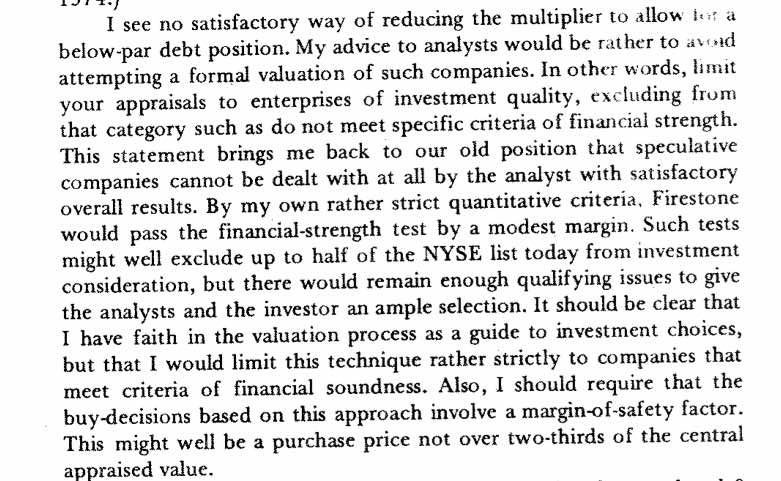V = {EPS x (8.5 + 2g) x 4.4} / Y, or Intrinsic Value = Earnings x (37½ + 8.8 G) ÷ AAA rate. All warnings that Graham gave with the original formula would apply here as well.
The Original Formula
The formula actually published by Graham is:
V = EPS x (8.5 + 2g), or
Value = Current (Normal) Earnings x (8.5 plus twice the expected annual growth rate)
Benjamin Graham, Chapter 11: Security Analysis for the Lay Investor, The Intelligent Investor.
The Updated Formula
However, some sources refer to the following as Benjamin Graham's updated Intrinsic Value formula:
V = {EPS x (8.5 + 2g) x 4.4} / Y
where:
V: Intrinsic Value of the company, EPS: the company's last 12-month earnings per share, 8.5: the appropriate P-E ratio for a no-growth company as proposed by Graham, g: the company's long-term (five years) earnings growth estimate, 4.4: the average yield of high-grade corporate bonds, Y: the current yield on 20 year AAA corporate bonds.
Source
Given below is a screenshot from a transcript of the interview — The Decade 1965-1974: Its significance for Financial Analysts [PDF] — where Graham supposedly makes a passing reference to the adjustment.
A few paragraphs later, he can again be seen expressing several misgivings about such simplistic formulas.
Particularly note that part where Graham says "By my own rather strict quantitative criteria". Here he is referring to his stock selection framework published in The Intelligent Investor, which includes elaborate tests for financial strength and other factors.
The Intelligent Investor
Lastly, please note that this updated formula is not from a published source. Here's what Graham actually writes on the topic of interest rates along with the original formula in The Intelligent Investor:
We should point out that any “scientific,” or at least reasonably dependable, stock evaluation based on anticipated future results must take future interest rates into account. A given schedule of expected earnings, or dividends, would have a smaller present value if we assume a higher than if we assume a lower interest structure. Such assumptions have always been difficult to make with any degree of confidence, and the recent violent swings in long-term interest rates render forecasts of this sort almost presumptuous. Hence we have retained our old formula above, simply because no new one would appear more plausible.
Benjamin Graham, Chapter 11: Security Analysis for the Lay Investor, The Intelligent Investor.
So again, Graham never intended this formula — or any of its variations — to be used for stock selection by his readers. He was simply advising users of all such simplistic valuation methods to include all the requisite tests for financial soundness and a Margin of Safety.

